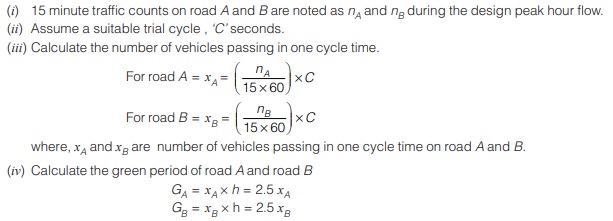Traffic Signals
A traffic signal is defined as any power operated traffic control device or a sign by which traffic is warned or directed to take some specific action. Traffic signals is a device which is used to direct the traffic to stop and proceed at intersections using red and green traffic light signals automatically.
- Advantages of Traffic Signals:
(i) They provide orderly movement of traffic and increase the traffic handling capacity of most of the intersections at grade.
(ii) They reduce certain types of accidents mainly the right angled collisions.
(iii) In the effective use of signal system, reasonable speed is maintained along the major road traffic.
(iv) Signals provide a chance to crossing traffic of minor road to cross path of continuous flow of traffic stream at reasonable intervals of time.
(v) Automatic traffic signal may work out to be economical when compared to manual control. - Disadvantages of Traffic Signals:
(i) Improper design and location of signals may lead to violations of the traffic control system
(ii) Failure of the signal due to electric power failure or any other defect may cause confusion to the road users.
Type of Traffic Signals
(i) Traffic Control Signals: Traffic Control Signals have three coloured light glows facing each direction of traffic flow. The red light is meant for “Stop”, Green light indicates “GO” and the amber light allows the clearance time for the vehicles which enter the intersection area by the end of green time. Traffic control signals are of three types:
(a) Fixed time signal
(b) Manually operated signal
(c) Traffic actuated (automatic) signal
In Fixed Time Signal the timing of each phase of the cycle is predetermined base on the traffic studies. The main drawback of this is that some times the traffic flow on one road may be almost nil and traffic on cross road may be quite heavy but signal operates with fixed timings. Traffic actuated signals are those in which the timings of phase and cycle are changed according to traffic demand.
(ii) Pedestrian Signal: It is used to give the right of way to pedestrians to cross a road when the vehicular traffic shall be stopped by stop signal.
(iii) Special Traffic Signal: Special traffic signal such as “FLASHING BEACONS” are meant to Warn the traffic. When signal is flashing red then the vehicles shall stop before entering the nearest crosswalk at an intersection.
While flashing yellow signals are caution signals meant to signify that drivers may proceed with caution.
Types of Traffic Signal System
There are four general types of signal system:
(i) Simultaneous System: In this system all the signals show the same indication at the same time. As the division of cycle is also the same at all intersections, this system does not work satisfactorily.
(ii) Alternate System: It shows opposite indications in a route at the same time and this system is more satisfactory than the simultaneous system.
(iii) Simple Progressive System: A time schedule is made to permit, as nearly as possible a continuous operation of groups of vehicles along the main road at a reasonable speed. The phases and intervals at each signal installation may be different but each signal unit works as fixed time signal with equal signal cycle length.
(iv) Flexible Progressive System: In this system we can vary the length of cycle, cycle division and the time schedule at each signalized intersection automatically with the help of a computer. It is the most efficient system.
Elements used in the Design of Traffic Signals
(i) Cycle Length (CO): It indicates the time interval between starting of signal such as green to the next time green Starts.
(ii) Interval: It indicates the change from one stage to another. There are two types of interval:
- Change interval: It is Change interval: also called yellow time and it indicates the interval between green and
red Signal. - Clearance interval: It is Clearance interval: also known as all red time and is included after each yellow interval indicating a period during which all signal phases shows red and it is used for clearing of vehicles at the intersections.
Total cycle length = Green interval + Red interval + Change interval
Methods of Signal Designing
There are various method of signal designing:
(i) Trial Cycle Method
(ii) Approximate Method
(iii) Webster Method
(iv) IRC Method
(i) Trial Cycle Method
In this method green time is calculated on the basis of number of vehicles per hour accumulated at intersection. Steps involved in this method are as follows:

<< Previous | Next >>
Must Read: What is Highway Engineering?

